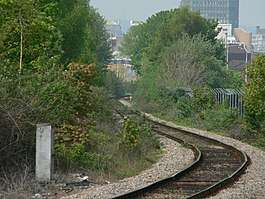Butetown branch line
The Butetown branch line, also known as the Cardiff Bay Line, is a 1-mile-6-chain (1.7 km) commuter railway line in Cardiff, Wales from Cardiff Bay and Cardiff Queen Street.[1] The service pattern used to comprise a mixture of shuttle services along the branch and through trains along the Rhymney Line to Caerphilly, or the Coryton Line to Coryton, but since December 2005 is a shuttle service from Queen Street station.
| Butetown branch line | |
|---|---|
 | |
| Overview | |
| Type | Heavy Rail |
| System | National Rail |
| Locale | Cardiff |
| Termini | Cardiff Bay Cardiff Queen Street |
| Stations | 2 |
| Operation | |
| Opened | 1840 |
| Owner | Network Rail |
| Operator(s) | Transport for Wales |
| Rolling stock | Class 150 Class 153 |
| Technical | |
| Line length | 1 mile 6 chains (1.7 km) |
| Number of tracks | Single track throughout |
| Track gauge | 4 ft 8 1⁄2 in (1,435 mm) standard gauge |
History
Originally a portion of the Taff Vale Railway's main line to Cardiff's Bute Docks, in 1922, it was absorbed, along with the neighbouring Rhymney Railway, into the enlarged Great Western Railway. With the decline of coal traffic and the closure of the Bute Docks, it now sees only passenger services, and is regarded as a branch from the line through to Cardiff Central.
At privatisation in 1995, services were operated by the Cardiff Railway Company, which traded as Valley Lines. This was subsumed by the new Wales & Borders franchise in 2001, which was subsequently awarded to Arriva UK Trains in December 2003 and operated as Arriva Trains Wales. In October 2018, Transport for Wales took over the franchise from Arriva Trains Wales.
The December 2005 timetable introduced a further increase in services to 4 trains per hour 18 hours a day, and even a Sunday service for the first time (further improved in June 2006 to offer the same 4 trains per hour service from 11am to 4pm). In December 2005, Arriva employed a single car Class 153 to "shuttle" along the Butetown Line, upgrading from the 2 car Class 143 'Pacers' used for the service. Since then, the service frequency has been increased even more – there are now 5 trains per hour on the line every day of the week, which equates to one train every 12 minutes.
In July 2006 the service was due to be provided by a 1950s Class 121 "Bubble car" DMU. The unit finally entered service on 17 August 2006, only to be withdrawn for repairs two days later. The unit then re-entered service on 14 September 2006.
Butetown branch line | |||||||||||||||||||||||||||||||||||||||||||||||||||||||||||||||||||||||||||||
|---|---|---|---|---|---|---|---|---|---|---|---|---|---|---|---|---|---|---|---|---|---|---|---|---|---|---|---|---|---|---|---|---|---|---|---|---|---|---|---|---|---|---|---|---|---|---|---|---|---|---|---|---|---|---|---|---|---|---|---|---|---|---|---|---|---|---|---|---|---|---|---|---|---|---|---|---|---|
| |||||||||||||||||||||||||||||||||||||||||||||||||||||||||||||||||||||||||||||
Passenger volume
Below is the passenger volume from the year beginning April 2002 to the year beginning April 2015. Comparing the two years, Cardiff Queen Street's usage has increased by 44% whilst Cardiff Bay has increased 569%.[2]
| Station usage | ||||||||||||||||
|---|---|---|---|---|---|---|---|---|---|---|---|---|---|---|---|---|
| Station name | 2002–03 | 2004–05 | 2005–06 | 2006–07 | 2007–08 | 2008–09 | 2009–10 | 2010–11 | 2011–12 | 2012–13 | 2013–14 | 2014–15 | 2015–16 | 2016–17 | 2017–18 | 2018–19 |
| Cardiff Queen Street | 1,841,260 | 2,072,551 | 2,126,479 | 2,231,784 | 2,486,005 | 2,559,748 | 2,437,638 | 2,411,438 | 2,488,920 | 2,495,238 | 2,462,700 | 2,523,314 | 2,643,568 | |||
| Cardiff Bay | 177,911 | 245,910 | 274,133 | 404,049 | 518,572 | 594,520 | 685,608 | 753,148 | 793,382 | 869,126 | 1,019,348 | 1,143,746 | 1,190,780 | |||
| The annual passenger usage is based on sales of tickets in stated financial years from Office of Rail Regulation statistics. The statistics are for passengers arriving and departing from each station and cover twelve month periods that start in April. Methodology may vary year on year. Barking and Blackhorse Road are affected by usage of the ticket gates for the underground and that Gospel Oak connects to the North London Line section of the London Overground and is similarly affected. Barking is further affected by the ticket gates used to access C2C services. | ||||||||||||||||
Modernisation
On 16 July 2012, plans to electrify the line were announced by the government, as part of a £9.4bn package of investment of the railways in England and Wales.[3]
The announcement was made as an extension of the electrification of the South Wales Main Line from Cardiff to Swansea and the electrification of the south Wales Valley Lines at a total cost of £350 million. It was proposed to start between 2014 and 2019.[4]
In June 2018 it was announced by the new operator Transport for Wales Rail that the line was to be re-integrated into Valley Lines services, with 6 trains per hour to operate from Merthyr Tydfil, Aberdare and Treherbert.[5] New stations will be constructed at Loudoun Square and on a short extension from the current station closer to Cardiff Bay, opening in December 2023. The current Cardiff Bay station will close at the same time. Stadler Citylink tram-trains will replace the Class 153s. These will switch to battery power on the branch, negating the need for electrification.[6]
References
| Wikimedia Commons has media related to Butetown Branch Line. |
- Yonge, John; Padgett, David (August 2010) [1989]. Bridge, Mike (ed.). Railway Track Diagrams 3: Western (5th ed.). Bradford on Avon: Trackmaps. maps 22 & 28B. ISBN 978-0-9549866-6-7.CS1 maint: ref=harv (link)
- "Station usage". Office of Rail Regulation. Retrieved 10 May 2012.
- BBC News – £9bn railway investment announced by coalition
- BBC News – Rail electrification to Swansea and south Wales valleys welcomed
- "What's Happening in South East Wales | Transport for Wales". tfw.gov.wales. Retrieved 25 October 2018.
- https://www.walesonline.co.uk/business/business-news/huge-investment-running-billions-transform-14738004
